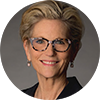Download PDF

A year ago, as we emerged from the first pandemic lockdown, peaceful protests and destructive riots erupted in response to the death of George Floyd. While seemingly unrelated, the twin cataclysms of 2020—the pandemic and the profound social unrest—intersect for physicians in one issue: health care disparities.
It’s now well known that COVID-19 disproportionately affects people of ethnic minorities. In my suburban community, some acquaintances don’t know a single person who has died from COVID. In contrast, my friend Anne, who lives 20 miles away in a predominantly Black neighborhood in Chicago, says, “Everyone I know has a friend or family member who has been very sick with COVID or has died.”
Now, due to increased awareness, many ophthalmologists are asking how they and their institutions might help address health care disparities.
Trained as a glaucoma specialist and now president of Wayne State University in Detroit, Roy Wilson sees a connection between the disparities of COVID disease and systemic conditions that are more chronic in nature. “What strikes me is the heightened awareness of the health disparities, because death from COVID happened so quickly,” Roy said. “In contrast, the other diseases that disproportionately affect Black people—like diabetes and hypertension—happen over a long period of time, and outcomes are more difficult to study. This is an unprecedented opportunity to study these disparities and to shed light more broadly.”
He suggested that ophthalmology organizations commit additional resources to combating glaucoma—another chronic disease that disproportionately affects Blacks. And he offered strategies for increasing glaucoma awareness in the community, such as developing educational videos that can be shown in churches, providing culturally sensitive patient education literature, reaching out to local primary care physicians, and offering health fair screenings (as long as the screenings don’t give false assurances, he warned).
Patients also need greater access to ophthalmic care. Terri Young, a pediatric ophthalmologist and chair of ophthalmology at the University of Wisconsin in Madison, emphasized the overwhelming need for ophthalmology care, especially subspecialty care, in many under-resourced communities. “I have great respect for ophthalmologists who volunteer in other countries, and I’ve done so myself, but remember, there is great need very close to home.”
Terri also noted that some clinics continue to segregate Medicaid patients from their private insurance patients, which creates a dual system of care instead of cultivating equality of care. “Integrating these patients is a simple and practical way that we can begin to address health disparities.”
Academy President Tamara Fountain cited several social determinants of health, including the long-term impact of living in low-income housing on education, wealth, available jobs, and health insurance—as well as the accompanying lack of access to grocery stores and transportation. She believes that we can make a difference by committing resources and diversifying leadership. She encouraged ophthalmic organizations to include photos of underrepresented minorities in patient education literature, especially brochures and digital content about glaucoma and diabetic retinopathy. Finally, she emphasized the role of public policy and encouraged ophthalmologists to learn the relevant processes and to get involved.
Indeed, the causes of health care disparities are myriad and complex. As Tamara observed, “If this were an easy problem to fix, we’d have it figured out.” Still, I’m encouraged by the practical, actionable steps that she, Roy, and Terri have shared. And I’m reminded of the oft-quoted words from the Pirkei Avot: “You are not obligated to complete the work, but neither are you free to abandon it.”1 Going forward, each of us can do some reading and reflecting—and then decide how to do our part.
___________________________
1 Taylor C, trans. Pirkei Avot: Sayings of the Jewish Fathers. CreateSpace Independent Publishing Platform; 2016.